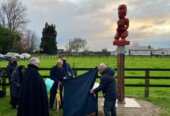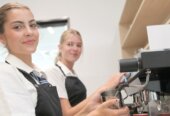
Dactylanthus taylorii is New Zealand’s only fully parasitic plant and grows on the roots of about 30 species of trees – it’s flower, often referred to as the wood rose, is attractive to pests.
Intrepid members of the Pirongia Te Aroaro o Kahu Restoration Society have completed their third summer trip to the mountain’s highest reaches to continue ongoing work protecting a rare New Zealand plant species.
The group – active in conservation and restoration projects at Mt Pirongia for 14 years – is undertaking a range of work to protect the Dactylanthus taylorii (pua o te reinga), a small native plant which is parasitic and grows underground.
The Dactylanthus flower above ground and is particularly attractive to possums, as well as goats and rats – so the plant specimens monitored by the society are caged to protect them from these predators.

Liz Overdyke helps with the protections of pua o te reinga on Pirongia.
The society’s chair Clare St Pierre says the focus of recent trips up the mountain by group members has been to assess the flowering of the Dactylanthus and to carry out hand pollination.
“The main pollinator of these plants has historically been the short-tailed bat (or pekapeka), and unfortunately that’s a species locally extinct at Pirongia – hence our members are literally down on their hands and knees, using tweezers to collect pollen from the male flower and apply it to the females to complement other natural pollination that may occur,” Mrs St Pierre says.
Pollination must occur in summer.
“We have a small window of time when the plants are flowering when we need to get this sort of hands-on work done. It’s vital to ensure the plants produce seed for the future population of the species.”
The group’s trip last week included caging three new Dactylanthus plants and repairing other cages damaged by possums which have been eating the flowers.
Cara Hansen, Department of Conservation Biodiversity Ranger, says the society’s work is a vital part of rebuilding the mountain’s ecosystem.
“The work the group does is fundamental to a long-term effort underway to maintain some of the conservation wins we’ve had on the mountain in recent years. Without the society’s commitment a lot of the work undertaken on the mountain wouldn’t be possible,” she says.
“The Department, local iwi and the society have been developing a restoration plan to guide the group’s work over the next five years.”

Alison Sellars checks the robustness of a cage protecting the plants.
The society’s next trip up the mountain will be in June, to determine how successful the hand pollination has been, by assessing the resulting seed production.








